
1960’s gave us the sexual revolution. They also gave us sex researchers William Masters and Virginia Johnson who pioneered research into the nature of human sexual response and the diagnosis and treatment of sexual disorders and dysfunctions. In the initial phase of Masters and Johnson’s studies, from 1957 until 1965, they recorded some of the first laboratory data on the anatomy and physiology of human sexual response based on direct observation of 382 women and 312 men in what they conservatively estimated to be “10,000 complete cycles of sexual response”. That’s a lot of complete cycles of sexual response! One of the most enduring and important aspects of their work has been the four stage model of sexual response, which they described as the human sexual response cycleand defined as:
1.Desire or excitement: During the desire phase, the tissue in the penis, vagina, pelvis, vulva, and clitoris fill with blood. This increases the sensitivity of nerves in these areas of the body. This blood flow also creates a fluid called transudate, which lubricates the vagina. Muscles throughout the body begin contracting. Some people breathe more rapidly or develop flushed skin due to the increased blood flow.
2.Plateau: During the plateau stage, a person’s arousal continues to intensify. The vagina, penis, and clitoris become more sensitive. A person may experience variations in sensitivity and arousal during this period. Arousal and interest may decrease, intensify, then decrease again.
3.Orgasm: With the right stimulation and the right mental state, a person may have an orgasm. For most females, clitoral stimulation is the fastest, most effective path to orgasm. For some, it is the only path to orgasm. Males may need prolonged stimulation of the shaft or head of the penis. Most males ejaculate during orgasm, but it is possible to have an orgasm without ejaculating. Some females also ejaculate during orgasm, though the content of this fluid remains the subject of scientific discussion. Both males and females experience intense muscle contractions during orgasm. Males experience these contractions in the rectum, penis, and pelvis, while females experience them in the vagina, uterus, and rectum. Some people experience contractions throughout the entire body.
4.Resolution: After orgasm, the muscles relax, and the body slowly returns to its pre-arousal state. This process is different for males and females. Although most males cannot have an orgasm immediately after ejaculating, many females can. During the resolution stage, most males and many females experience a refractory period. During this time, the person will not respond to sexual stimulation.
There is no “right” way to feel about sex and no correct way to have sex. People can experience sexual pleasure from a wide range of positions, types of sex, and sexual fantasies. The key is to know what you like and how you like it and then guide your partner in a way that is pleasurable for both of you.
Story by Astrid Buck.

